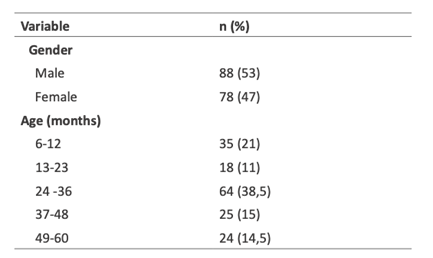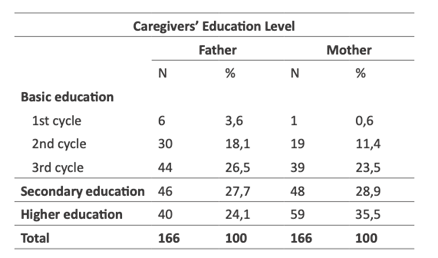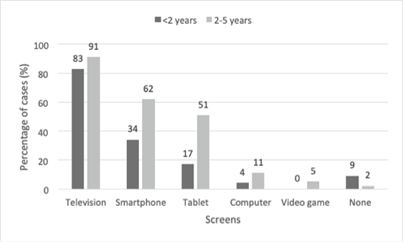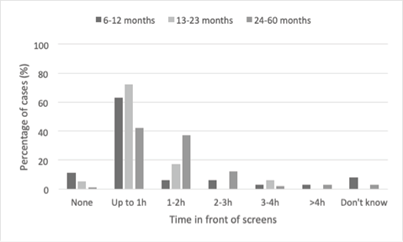Introduction
Nowadays more children, even in economically challenged households, are using newer digital technologies, such as interactive and mobile media and continue to be the target of intense marketing. According to recent data, children three to five years old spend an average of two hours per day on television (TV), which account for 78% of total screen time for this age group.1,2 Many preschoolers accumulate screen time at home and in child care, from a variety of screens that are easily transportable. International studies show that rates of mobile media use among two to four-years-old increased from 39% to 80% between 2011 and 2013.3-6 Another recent study found that about 51% of infants aged six to 11-months-old use a touch screen daily and that the average child between eight months and eight years of age is exposed to nearly four hours of background TV on a typical day.7
Whether early exposure to screen media changes the developing brain is actually not known.8,9 Still, studies show that while babies do not absorb content from TV, it can catch and hold their attention. They can imitate specific actions they see on screen between six and 14 months, and remember brief sequences by 18 months.8
Beginning at about two years, quality TV with well-designed and age-appropriate programs with specific educational goals can provide an additional route to early language and literacy for children.10 Quality programming also fosters aspects of cognitive development, including imaginative play. Early evidence suggests that interactive media, specifically applications that involve contingent responses from an adult (i.e., timely reactions to what a child says or does), can help children retain taught information. This responsiveness, when coupled with age-appropriate content, timing and intensity of action, can teach new words to two-years-old children.9,11,12 Appropriate use can also be powerfully pro-social, helping children to learn antiviolence attitudes, empathy, tolerance and respect.13 Potential benefits can also be seen on physical health.14
Despite these potential benefits from a limited use of high-quality and appropriate media, many negative health effects can also result. Population-based studies continue to show associations, although not direct causal relationships, between excessive screen exposure (more than two hours/day in some studies) in early childhood and significant cognitive, language, and social/emotional delays.15,16 Possible mechanisms for these outcomes include the effects of viewing inappropriate, adult-oriented content (as well as some inappropriate child-directed content), a decrease in parent-child interaction when the screen is on, and poorer family functioning in households with high media use.17-19
Preliminary data from the Adolescent Brain Cognitive Development study showed that heavy screen use was associated with a premature and accelerated thinning of the cortex in children.20 Recent evidence suggests an association between elevated levels of TV exposure at age two with self-regulation difficulties in early childhood and self-reported victimization, social isolation, proactive aggression and anti-social behaviors in middle childhood.15
High levels of screen time are also linked to obesity and cardiovascular risk.21 The association between using screens and obesity persists throughout the life course even after adjusting for children’s psychosocial risk factors or behavioral problems.
Sleep is also negatively affected by media use.22 Increased duration of media exposure and the presence of a TV, computer, or mobile device in the bedroom in early childhood have been associated with fewer minutes of sleep per night, due in part to suppression of endogenous melatonin by blue light emitted from screens.23 Daytime and bedtime use of electronic devices both affected sleep measures, with an increased risk of short sleep duration, long sleep onset latency, and increased sleep deficiency. Besides that, not getting enough sleep can deeply impact the attention, mood and irritability.24
Taking into account all these facts, the World Health Organization, the European Academy of Paediatrics, and the American Academy of Pediatrics in their recently published statements, agree that children under the age of two should have no screen time, except video-calls on rare occasions, and that children under the age of five should be supervised while engaging with media, limiting screen use to one hour per day.15,25,26 This position is also defended by the Canadian Paediatric Society.27 The essential advice both European, American and Canadian experts agree on, is that parents should actively engage and interpret the digital content to their children, so they can develop their ability to filter information, critically analyse what they view and discuss the meaning of the information they receive.
In this study we intend to characterize the screen time habits in a healthy population of children aged between six months and five years, from two Family Health Units (FHU) of an urban area in northern Portugal and to determine the level of parental awareness on screen time recommendations.
We discuss the effects of screen exposure and use on children younger than five years based on a literature search which included systematic reviews, guidelines and policy statements on screen media exposure and use. We focus on this age group because research recognizes important developmental differences between early and later childhood. Studies that address this topic in Portuguese children of this specific age group are still limited.
Material and methods
An observational and analytical cross-sectional study was conducted by using an individual, confidential and anonymous questionnaire, which was applied to the parents of children assessed at a scheduled surveillance visit at two FHUs in an urban area of northern Portugal, between February and July 2018. Inclusion criteria were: 1) patients with ≥ 6 months and ≤ 5 years of age at the time of the study 2) patients that were being followed in the FHUs mentioned in the study and 3) patients with family doctor assigned. Exclusion criteria were: 1) older children and adolescents and 2) children with neurodevelopmental disorders. Children who had more than one appointment in this period were included only once. When a family involved more than one child, each child was included separately.
The study was approved by the Clinical and Health Council of the Grande Porto IV-Póvoa de Varzim/Vila do Conde Health Group Center and by the Ethics Committee of the Northern Region Health Administration. The questionnaires were delivered to parents before medical appointment. At that time, the purpose of the study was explained, reinforcing the confidential and non-mandatory nature of completing the surveys. After oral informed consent was obtained from the parents, the inquiries were collected in a closed box placed at the entrance of the FHUs. The questionnaire consisted of ten questions elaborated by the authors (Figure I).
For the descriptive analysis of the data, the categorical variables were presented in frequencies and percentages and the continuous variables in mean and standard deviation. For the analytical study, chi-square and Student’s t-tests were used at a significance level of 0.05. Data were analyzed using Statistical Package for the Social Sciences (SPSS) software, version 22.0 (IBM, Inc).
Results
A total of 166 children were included in the study. Of these, 53% (n=88) were males. The mean age was 30 months (median 24 months) - Table I. About 25% (n=40) of fathers and 35% (n=59) of mothers had higher education (Figure II). Both parents were employed in 78% (n=129) of the cases, and in 86% (n=143) the average monthly family income was up to four times the minimum wage.
In comparison with other devices, television dominated total screen time (counting for 83% for children under two years and 91,2% for children aged two to five years), followed by smartphone and tablet (Figure III). We found in our study that almost all children (n=146; 88%) began screen exposure before two years of age (about 42% began screen exposure between six and 12 months and 21% before six months of age). We also realized that 85% of children under two years-old (n=45) and 80% of infants 6 to 12-months-old (n=28) was exposed to screens daily, with most of them spending up to one hour per day in front of screens (Figure IV).
This study also noted that 57,5% of children aged two years and older exceeded the widely suggested limit of no more than one hour per day, with the majority using screens between one to two hours per day (Figure IV). In this age group, about 65% (n=73) of parents affirmed that they were often or always present when screens were used and 76% (n=86) had laid down limits on their children’s screen time. About 90% (n=102) also stated that they frequently or always control the content of screen programs and activities of their children.
Overall, only 39% (n=65) of parents affirmed to know current guidelines for screen time use, although 72% (n=120) had ensured they knew about the existence of potential risks associated with heavy screen exposure at an early age. Among those parents who claimed to know about screen time recommendations (n=65; 39%), less than a half were actually right (n=28; 43%).
In our study, screen time use was not related with parents’ socioeconomic or academic status (p>0,05). Parents’ knowledge about current guidelines also did not minimize children’s screen use (p=0,094).
Discussion
The results of this study confirm that children are starting to consume media at very early ages. Although current European, American and Canadian guidelines agree that children under the age of two years should have no screen time, we found in our study that 85% of children in this age group were exposed to screens every day. It is also important to reinforce that, in our study, more than one out of five children began screen exposure before six months of age.15,26,27
This finding is particularly important because before two years of age, children are still developing cognitive, language, sensorimotor, and social-emotional skills, which require hands-on exploration and social interaction with trusted caregivers for successful maturation.28 There is solid evidence that infants and toddlers have difficulty transferring new learning from a 2D representation to a 3D object (e.g., from screen to real life) and are unlikely to learn from screens at this age. Early learning is easier, more enriching and developmentally more efficient when experienced live, interactively, in real time and space, and with real people.
Television stand out as the most used device perhaps because it is the most popular media device in today’s society and it is also the most accessible to the child.2,29 The benefits of television are unquestionable when it comes to selected and quality educational programs, but the potential negative effects of TV exposure are worrisome, not only because of the often inappropriate content for the population concerned, but also for reducing the amount and quality of parent-child interaction and the time spent in activities that promote child development, such as physical exercise, exploration of the environment and social interaction.15 In a recent study, parents reported that shifting attention between screens and family life can be stressful, tiring and reduces their ability to interact ‘in the moment’ with children.30
Screen use in the early years can become routine and place children at higher risk for being sedentary and overweight.31 A task force from the European Academy of Paediatrics and the European Childhood Obesity Group confirmed a strong link between obesity levels across European countries and childhood media exposure, promoted not only by the amount of sedentary time spent watching TV, but also by caloric food products advertising.26 A systematic review of TV watching and adverse dietary effects in children two to six years old found most studies reported negative effects with as little as one hour/day of viewing.32 Several studies have also found that the association between TV viewing and obesity remained significant when potential confounding variables were taken into account, namely socioeconomic status, a family predisposition to obesity and even levels of physical activity.26
High exposure to background TV appears to negatively affect language use and acquisition, attention, cognitive development and executive function in children younger than five years.11,33,34 Some studies associate prolonged TV viewing with lower cognitive abilities, especially related to short-term memory, early reading and math skills.3,35 Fast-paced or violent content can negatively impact executive function and these effects may be cumulative.18,34 Indeed, the inability of young children (especially those younger than two years) to distinguish everyday reality from what happens on screen, along with their efforts to make sense of competing experiential realms, may interfere with and impede executive function.8
Another important finding in this study was the substantial percentage of parents that controlled the content of programs, were involved with and set limits on children’s screen time aged two years and older. Although we don’t know what programs these children were exactly watching, studies have shown that co-viewing screen content can influence children’s social adaptive skills, sleep patterns and behaviors from these age on.11,36 Setting screen time limits is also essential because most adverse effects come from excess use. When children are spending hours tied to smartphones or playing video games, then the issues related to obesity, attention and emotional development may arise. Setting meaningful limits when children are young and sharing them as a family is far easier than cutting back screen time when children are older. Studies have found that parents’ comfort level with saying ‘no’ to their children’s requests to play games on screen, along with their own media-related beliefs, intentions and attitudes, are key components of constructive, positive limit-setting.36,37
Although some international surveys show greater exposure to screens in lower-income families, we did not verify this fact in our study. Indeed, socioeconomic status appears to have little bearing on the degree to which families comply with current screen guidelines.30,38 Thus, we think that excessive levels of screen media exposure are associated more strongly with low levels of stimulation in the home and low parental involvement than with socioeconomic position.
Given that most parents were unaware of current screen time recommendations, it is still worrying that among those who claimed to know these guidelines, less than a half were correct (most of them reported times higher than those actually recommended). Besides that, although they had claimed to know the presence of potential risks associated with heavy early screen exposure, they did not minimize young children’s screen time, which affects face-to-face interactions and impairs young children learning. This finding demonstrates that parents and society need a better understanding of the influence of social media on children.
Although a gap in terms of access and usage of quality digital content may exist, it is now clear that most young children accompanied by a pediatric or family health care provider will have used or have been exposed to mobile technology. It is therefore urgent to recognize these evidences and to establish intervention strategies in children and their families. Healthcare professionals are in a special position to educate parents and children about the social and health issues connected to digital and traditional media. All of us must work to make parents realize that putting children most of their time in front of screens is an easy solution but the harder way might be better and, in the end, might be more beneficial. Current recommendation is that families should negotiate screen time limits with their children based upon the needs of an individual child, the ways in which screens are used and the degree to which use of screens appears to displace (or not) physical and social activities and sleep (screens are to be avoided an hour before the planned bedtime).39
In this study the authors acknowledge the existence of some biases and limitations, namely the use of an not validated questionnaire, the fact that it was filled by parents, so some data may have been underestimated, particularly regarding screen exposure (for example, parents may have considered only a continuous period of time and may not have included every minute during the 24 hours on a regular day in which children have access to screens), the fact that we have not separated screen time on weekdays and weekends and that the sample was obtained in only two FHU and, as such, should not be seen as representative of the Portuguese population. Despite that, we want to reinforce the importance of these data in the characterization of the screen time habits profile in very young children. Further research is needed to better understand the impact of screen use on children and to develop effective strategies to reduce long-term media use by this young population.
Conclusions
Young children are exceeding screen time recommendations. It is important that pediatricians, family doctors and other health care providers advice parents that new media use have some benefits, but these benefits largely depend on a child’s age and developmental stage, a child’s characteristics, how the media are used, and the media content and design, in order to not interfere with critical learning experiences and healthy behaviors. For children and parents off-screen time is critical for developing essential life skills such as self-regulation, creativity and learning through physical and imaginative play. Raising awareness of how children learn best and their need for screen time limits is important for all families, regardless of economic circumstances. It would be important to create Portuguese health policies regarding screen time use and consider children’s screen time as an evaluation parameter in any consultation. Creating media literacy should be included in health promotion services delivered to families and children. This knowledge will guide parents toward media parenting practices that work to achieve the current screen time recommendations.
Take home messages:
Screen time for children younger than two years of age is not recommended; for children between two and five years of age, it should be limited to less than one hour per day.
Daily ‘screen-free’ time must be maintained, especially for family meals.
Screens must be avoided for at least one hour before bedtime, given the potential for melatonin-suppressing effects.
Parents should be present and engaged when screens are used by their children and prioritize educational, age-appropriate and interactive programming.
There is no evidence to support introducing technology at an early age; it is important to choose healthy alternatives, such as reading, outdoor play and creative, hands-on activities.



















